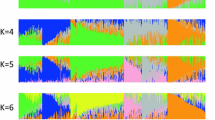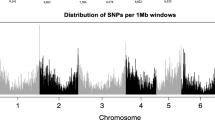Abstract
Recent advances in high-throughput sequencing technologies have triggered a shift toward single-nucleotide polymorphism (SNP) markers. A systematic bias can be introduced if SNPs are ascertained in a small panel of genotypes and then used for characterizing a larger population (ascertainment bias). With the objective of evaluating a potential ascertainment bias of the Illumina MaizeSNP50 array with respect to elite European maize dent and flint inbred lines, we compared the genetic diversity among these materials based on 731 amplified fragment length polymorphisms (AFLPs), 186 simple sequence repeats (SSRs), 41,434 SNPs of the MaizeSNP50 array (SNP-A), and two subsets of it, i.e., 30,068 Panzea (SNP-P) and 11,366 Syngenta markers (SNP-S). We evaluated the bias effects on major allele frequency, allele number, gene diversity, modified Roger’s distance (MRD), and on molecular variance (AMOVA). We revealed ascertainment bias in SNP-A, compared to AFLPs and SSRs. It affected especially European flint lines analyzed with markers (SNP-S) specifically developed to maximize differences among North American dent germplasm. The bias affected all genetic parameters, but did not substantially alter the relative distances between inbred lines within groups. For these reasons, we conclude that the SNP markers of the MaizeSNP50 array can be employed for breeding purposes in the investigated material. However, attention should be paid in case of comparisons between genotypes belonging to different heterotic groups. In this case, it is advisable to prefer a marker subset with potentially low ascertainment bias, like in our case the SNP-P marker set.


Similar content being viewed by others
References
Albrechtsen A, Nielsen FC, Nielsen R (2010) Ascertainment biases in SNP chips affect measures of population divergence. Mol Biol Evo 27:2534–2547
Charcosset A, Essioux L (1994) The effect of population-structure on the relationship between heterosis and heterozygosity at marker loci. Theor Appl Genet 89:336–343
Chen X, Cho YG, McCouch SR (2002) Sequence divergence of rice microsatellites in Oryza and other plant species. Mol Genet Genomics 268:331–343
Clark AG, Hubisz MJ, Bustamante CD, Williamson SH, Nielsen R (2005) Ascertainment bias in studies of human genome-wide polymorphism. Genome Res 15:1496–1502
Dray S, Dufour AB (2007) The ade4 package: implementing the duality diagram for ecologists. J Stat Softw 22:1–20
Efron, B, Tibshirani RJ (1993). An introduction to the bootstrap. Chapman and Hall, London, p 214
Elshire RJ, Glaubitz JC, Sun Q, Poland JA, Kawamoto K et al (2011) A robust, simple genotyping-by-sequencing (GBS) approach for high diversity species. PLoS ONE 6(5):e19379. doi:10.1371/journal.pone.0019379
Excoffier L, Smouse P, Quattro J (1992) Analysis of molecular variance inferred from metric distances among DNA haplotypes: application to human mitochondrial DNA restriction data. Genetics 131:479–491
Fischer S, Möhring J, Schön CC, Piepho HP, Klein D, Schipprack W, Utz HF, Melchinger AE, Reif JC (2008) Trends in genetic variance components during 30 years of hybrid maize breeding at the University of Hohenheim. Plant Breed 127:446–451
Ganal MW, Durstewitz G, Polley A, Berard A, Buckler ES, Charcosset A, Clarke JD, Graner EM, Hansen M, Joets J, Le Paslier MC, McMullen MD, Montalent P, Rose M, Schön CC, Sun Q, Walter H, Martin OC, Falque M (2011) A large maize (Zea mays L.) SNP genotyping array: development and germplasm genotyping, and genetic mapping to compare with the B73 reference genome. PLoS ONE 6:e28,334
Gore MA, Chia J-M, Elshire RJ, Sun Q, Ersoz ES et al (2009) A first generation haplotype map of maize. Science 326:1115–1117
Gort G, van Hintum T, van Eeuwijk F (2009) Homoplasy corrected estimation of genetic similarity from AFLP bands, and the effect of the number of bands on the precision of estimation. Theor Appl Genet 119:397–416
Gower JC (1966) Some distance properties of latent root and vector methods in multivariate analysis. Biometrika 53:325–338
Hamblin MT, Warburton ML, Buckler ES (2007) Empirical comparison of simple sequence repeats and single nucleotide polymorphisms in assessment of maize diversity and relatedness. PLoS ONE 2:e1367
Hübner S, Günter T, Flavell A, Fridman E, Graner A, Korol A, Schmid KJ (2012) Islands and streams: clusters and gene flow in wild barley populations from the Levant. Mol Ecol. doi:10.1111/j.1365-294X.2011.05434.x
Jackson D (1995) PROTEST: a PROcustean randomization TEST of community environment concordance. Ecosciences 2:297–303
Jannink JL, Lorenz AJ, Iwata H (2010) Genomic selection in plant breeding: from theory to practice. Brief Funct Genomics 9:166–177
Jones E, Sullivan H, Bhattramakki D, Smith J (2007) A comparison of simple sequence repeat and single nucleotide polymorphism marker technologies for the genotypic analysis of maize Zea mays L. Theor Appl Genet 115:361–371
Liu K, Muse S (2005) PowerMarker: an integrated analysis environment for genetic marker analysis. Bioinformatics 21:2128–2129
Lu Y, Yan J, Guimarães CT, Taba S, Hao Z, Gao S, Chen S, Li J, Zhang S, Vivek BS, Magorokosho C, Mugo S, Makumbi D, Parentoni SN, Shah T, Rong T, Crouch JH, Xu Y (2009) Molecular characterization of global maize breeding germplasm based on genome-wide single nucleotide polymorphisms. Theor Appl Genet 120:93–115
Mantel N (1967) The detection of disease clustering and a generalized regression approach. Cancer Res 27:209–220
Melchinger AE (1999) Genetic diversity and heterosis. In: Coors JG, Pandey S (eds) The genetics and exploitation of heterosis in crops. ASA-CSSA, Madison, WI, pp 99–118
Mezmouk S, Dubreuil P, Bosio M, Décousset L, Charcosset A, Praud S, Mangin B (2011) Effect of population structure corrections on the results of association mapping tests in complex maize diversity panels. Theor Appl Genet 122:1149–1160
Mikel MA, Dudley JW (2006) Evolution of North American dent corn from public to proprietary germplasm. Crop Sci 46:1193–1205
Moragues M, Comadran J, Waugh R, Milne I, Flavell AJ, Russell JR (2010) Effects of ascertainment bias and marker number on estimations of barley diversity from high-throughput SNP genotype data. Theor Appl Genet 120:1525–1534
Nielsen R, Signorovitch J (2003) Correcting for ascertainment biases when analyzing SNP data: applications to the estimation of linkage disequilibrium. Theor Popul Biol 63:245–255
Paradis E (2010) pegas: an R package for population genetics with an integrated-modular approach. Bioinformatics 26:419–420
Peleman J, van Wijk R, van Oeveren J, van Schaik R (2000) Linkage map integration: an integrated genetic map of Zea mays L. Poster P472. Plant and animal genome conference VIII, San Diego
R Development Core Team (2011) R: a language and environment for statistical computing. R foundation for statistical computing, Vienna, Austria, http://www.R-project.org/, ISBN 3-900051-07-0
Rafalski A (2002) Applications of single nucleotide polymorphisms in crop genetics. Curr Opin Plant Biol 5:94–100
Rafalski JA (2011) Genomic tools for the analysis of genetic diversity. Plant Genet Res Charact Util 9:159–162
Rafalski A, Tingey S (2008) SNPs and their use in maize. In: Henry RJ (ed) Plant genotyping II- SNP technology. CABI, Wallingford, Oxfordshire, UK; Cambridge, MA, pp 30–43
Ramìrez-Soriano A, Nielsen R (2009) Correcting estimators of and Tajima’s D for ascertainment biases caused by the single-nucleotide polymorphism discovery process. Genetics 181:701–710
Ramos AM, Crooijmans RPMA, Affara NA, Amaral AJ, Archibald AL et al (2009) Design of a high density SNP genotyping assay in the pig using SNPs identified and characterized by next generation sequencing technology. PLoS ONE 4:e6524
Schlötterer C (2004) The evolution of molecular markers—just a matter of fashion? Nat Rev Genet 5:63–69
Schrag TA, Melchinger AE, Sørensen AP, Frisch M (2006) Prediction of single-cross hybrid performance for grain yield and grain dry matter content in maize using AFLP markers associated with QTL. Theor Appl Genet 113:1037–1047
Schrag TA, Möhring J, Melchinger AE, Kusterer B, Dhillon BS, Piepho H-P, Frisch M (2010) Prediction of hybrid performance in maize using molecular markers and joint analyses of hybrids and parental inbreds. Theor Appl Genet 120:451–461
Seeb JE, Carvalho G, Hauser L, Naish K, Roberts S, Seeb LW (2011) Single-nucleotide polymorphism (SNP) discovery and applications of SNP genotyping in non-model organisms. Mol Ecol Res 11(Suppl 1):1–8
Sharopova N, McMullen MD, Schultz L, Schroeder S, Sanchez-Villeda H, Gardiner J, Bergstrom D, Houchins K, Melia-Hancock S, Musket T, Duru N, Polacco M, Edwards K, Ruff T, Register JC, Brouwer C, Thompson R, Velasco R, Chin E, Lee M, Woodman-Clikeman W, Long MJ, Liscum E, Cone K, Davis G, Coe EH Jr (2002) Development and mapping of SSR markers for maize. Plant Mol Biol 48:463–481
Technow F, Riedelsheimer C, Schrag TA, Melchinger AE (2012) Genomic prediction of hybrid performance in maize with models incorporating dominance and population specific marker effects. Theor Appl Genet. doi:10.1007/s00122-012-1905-8
Vekemans X, Beauwens T, Lemaire M, Roldan-Ruiz I (2002) Data from amplified fragment length polymorphism (AFLP) markers show indication of size homoplasy and of a relationship between degree of homoplasy and fragment size. Mol Ecol 11:139–151
Vos P, Hogers R, Bleeker M, Reijans M, Van de Lee T, Hornes M, Frijters A, Pot J, Peleman J, Kuiper M, Zabeau M (1995) AFLP—a new technique for DNA-fingerprinting. Nucleic Acids Res 23:4407–4414
Weir BS (1996) Genetic data analysis II. Sinauer Associates, Inc., Sunderland, MA
Weir BS, Cockerham CC (1984) Estimating F-statistics for the analysis of population structure. Evolution 38:1358–1370
Wright S (1978) Evolution and the genetics of populations. Variability within and among natural populations, vol 4. University of Chicago Press, Chicago, IL
Wright SI, Vroh Bi I, Schroeder SG, Yamasaki M, Doebley JF, McMullen MD, Gaut BS (2005) The effects of artificial selection on the maize genome. Science 308:1310–1314
Zhao W, Canaran P, Jurkuta R, Fulton T, Glaubitz J, Buckler E, Doebley J, Gaut B, Goodman M, Holland J, Kresovich S, McMullen M, Stein L, Ware D (2006) Panzea: a database and resource for molecular and functional diversity in the maize genome. Nucleic Acids Res 34:D752–D757
Acknowledgments
We thank H.-P. Piepho and K. J. Schmid for their useful comments and discussion and the two anonymous reviewers for their valuable suggestions. This research was funded by the German Federal Ministry of Education and Research (BMBF) within the AgroClustEr Synbreed—Synergistic plant and animal breeding (FKZ: 0315528d). E. Frascaroli was supported by the Deutscher Akademischer Austauschdienst (DAAD) grant A/11/04103.
Author information
Authors and Affiliations
Corresponding author
Additional information
Communicated by M. Xu.
Elisabetta Frascaroli and Tobias A. Schrag contributed equally to this work.
Electronic supplementary material
Below is the link to the electronic supplementary material.
Rights and permissions
About this article
Cite this article
Frascaroli, E., Schrag, T.A. & Melchinger, A.E. Genetic diversity analysis of elite European maize (Zea mays L.) inbred lines using AFLP, SSR, and SNP markers reveals ascertainment bias for a subset of SNPs. Theor Appl Genet 126, 133–141 (2013). https://doi.org/10.1007/s00122-012-1968-6
Received:
Accepted:
Published:
Issue Date:
DOI: https://doi.org/10.1007/s00122-012-1968-6




